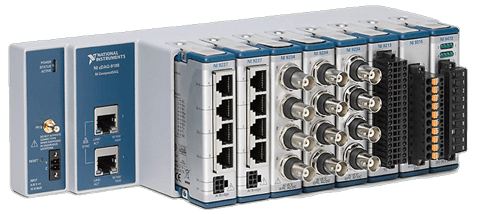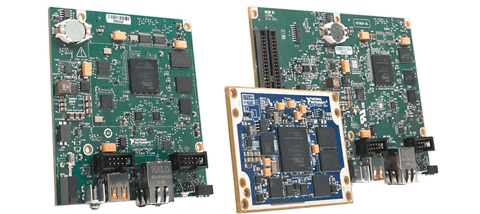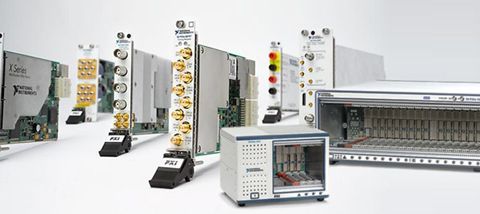Data Acquisition and Monitoring
What is a Data Acquisition System?
A data acquisition device acts as the interface between a computer and the signals from the outside world by digitizing incoming analog signals to be read by the computer. DAQ devices include three key components:
- Signal conditioning circuitry: transforms noisy real-world signals into forms that can be effectively and accurately measured.
- Analog-to-digital converters (ADCs): digitize real-world analog data into digital representations that can be manipulated by computers.
- Computer bus: enables the DAQ device to transmit data to a computer. Examples include USB, PCIe, or Ethernet.
Data acquisition plays a critical role in any application where you need to take accurate measures and make decisions based on it. It’s a basic pillar of applications in fields such as life science research, civil engineering, aerospace testing or industrial maintenance. The data gathered can be used to improve efficiency, ensure reliability or to make certain that machinery is operating safely.
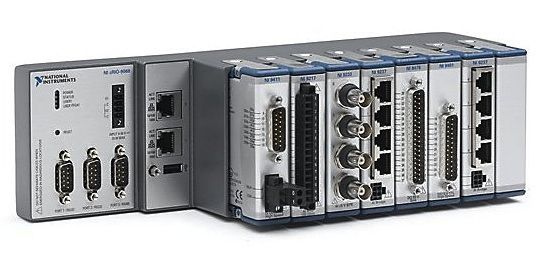
What Data Acquisition system do you need?
There are multiple choices for DAQ systems, so, depending on you needs and budget, you need to choose between the multiple options and make the right investment. For years, we have been working with our market leader partner NI to advise customers on what is their best investment option for a DAQ system, and based on that experience, here are our recommendations for proven system configurations based on your main need:
Do you have a small budget, but need a customizable and accurate system?
Pick a PC-based measurement and control system from our partner NI:
How does it work?
In this configuration, an NI hardware product is connected to your PC or laptop through USB or Ethernet. This kind of system has two main architectures:
- directly connect a multifunction I/O device to your PC, or
- connect a CompactDAQ Chassis to your PC, and populate it with conditioned I/O modules. CompactDAQ provides the most customizable solution with direct sensor connectivity.
Components of the system
- CompactDAQ Chassis with Conditioned I/O Modules.
- Multifunction I/O Devices: Provide combinations of analog I/O, digital I/O, and counter/timer functionality in a single device.
- Software.
Key Features
- Customization: You can quickly start capturing data from your measurements with DAQExpress™ companion software that is shipped with all PC-based DAQ hardware. Then, customize your measurement system, automate your measurements with LabVIEW, and perform advanced analysis, and integrate third-party instruments.
- Accuracy: CompactDAQ provides a modular, signal-conditioned architecture that gives you direct sensor connectivity, no matter your application requirements. Some CompactDAQ Chassis also support Time Sensitive Networking (TSN), an update to the Ethernet standard that provides synchronization and data transfer between multiple chassis, so there’s no need for separate timing and triggering wires.
- Advanced Driver functionality: NI-DAQmx allows you to specify every aspect of your DAQ system (including NI signal conditioning devices), from device configuration and timing setup to low-level OS and device control, all with one straightforward API. The NI-DAQmx driver is compatible with all NI DAQ hardware, so the same code can be used in different devices with no code changes. NI-DAQmx works with LabVIEW, DAQExpress, LabWindows™/CVI, C/C++, Visual Basic, Visual Basic .NET, and C#.
USB, Ethernet, Temperature, and Remote DAQ
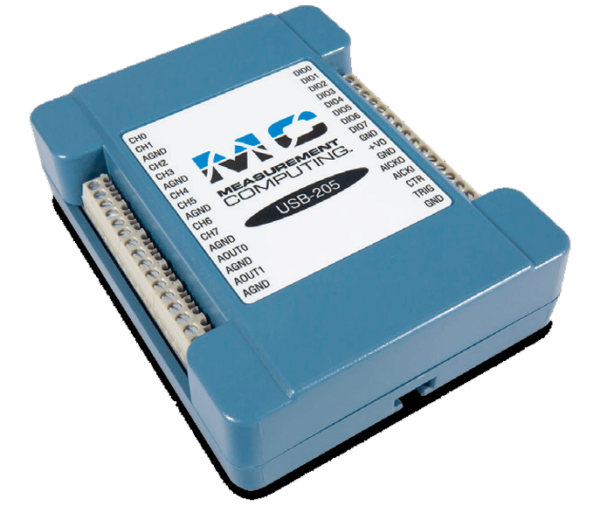 Multifunction USB DAQ
Multifunction USB DAQ
MCC multifunction data acquisition devices are available with analog input and output, digital I/O, and counter/timers to suite your various application requirements. Devices are available with up to 64 analog inputs, sample rates up to 2 MS/s, and resolution from 12-24 bits. Signal conditioning for measuring sensors like pressure, strain, and accelerometers is also available.
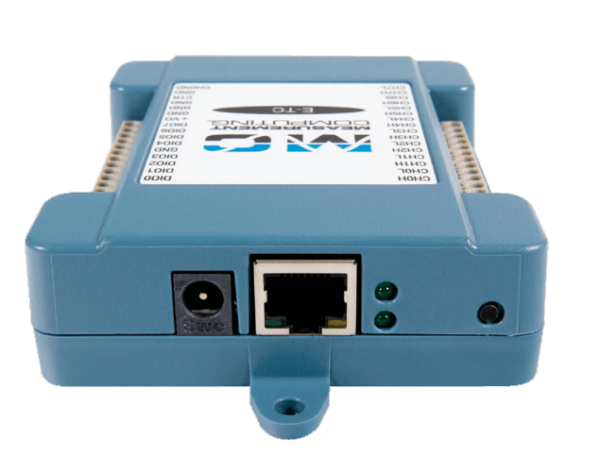 Ethernet DAQ
Ethernet DAQ
Ethernet-based data acquisition devices are ideal for remote measurement and control applications. These devices feature up to eight analog inputs, analog output, and digital I/O.
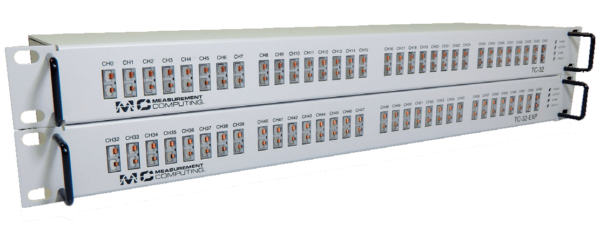 Temperature Measurement
Temperature Measurement
Temperature is one of the most common measurement types in DAQ applications. These devices are offered in USB, Ethernet, or stand alone configurations, with the ability to measure 8-64 thermocouples, RTD’s, or thermistors. Built-in cold-junction compensation and up to 24-bit resolution provide superior measurement capability.
Click here to learn the fundamental concepts of sensors and data acquisition
Do you need Advanced Control and Monitoring capabilities? Choose CompactRIO systems.
They have high-performance processing capabilities, sensor-specific conditioned I/O, and a closely integrated software toolchain that make them ideal for Industrial Internet of Things (IIoT), monitoring, and control applications
How does it work?
In a CompactRIO system, a controller with a processor and user-programmable FPGA is populated with one or more conditioned I/O modules from NI or third-party vendors. These modules provide direct sensor connectivity and specialty functions.
Components of the system
- Packaged controller or board-level controller, depending on your needs.
- Conditioned I/O modules: Connect to many sensors and buses and support measurements such as temperature, voltage, resistance, audio frequency, and more.
- Software: interoperable software products to meet your needs from interactive exploration to custom engineering design.
Key Features
- Faster development: use a single intuitive software tool chain: With a combination of NI Linux Real-Time, the LabVIEW FPGA Module, and the NI-DAQmx driver you can develop your system faster by programming both the processor and user-programmable FPGA with a single toolchain. You don’t need to focus low-level programming tasks or create and maintain I/O drivers, OSs, and other middleware.
- Accuracy: CompactRIO provides a modular, signal-conditioned architecture that gives you direct sensor connectivity, no matter your application requirements. Some CompactRIO Controllers also support Time Sensitive Networking (TSN), an update to standard Ethernet, so you can simplify your system setup by precisely synchronizing devices over the network. TSN also enables traffic scheduling on the network for the deterministic, low-latency transfer of time-sensitive data.
- Multiple form-factors: depending on whether you need to prototype an application or are ready for large-scale deployment, you can pick a packaged format or a board-level form factor. CompactRIO Controllers are built according to stringent design practices and undergo extensive testing and validation to ensure reliable operation in harsh industrial environments.
- Open and secure platform: leverage NI Linux Real-Time OS through thousands of open-source applications, IP, and examples, while collaborating with an active community of users and developers.
See how Duke Energy Takes Advantage of IIoT for Predictive Maintenance Applications
Do you need to develop an application with a large number of channels? Choose a PXI system.
Whether for device validation or for an Automated Test System, PXI systems provide high-performance modular instruments and other I/O modules that feature specialized synchronization and key software features.
How does it work?
In a PXI system, a chassis provides power, cooling, and a communication bus for modular instruments or I/O modules. You can control these modules from either an embedded controller or an external PC, using one or several of NI’s specialized engineering software tools to customize your system.
Components of the system
- PXI Chassis: houses PXI modules and controllers and connects them with a high-performance backplane that offers timing and synchronization capabilities.
- PXI Controller: contains everything you need to run your PXI system without an external PC or lets you control your PXI system from desktops, laptops, or server computers.
- PXI Modules: interface to bus standards, acquire data and images, trigger and synchronize devices, generate and route signals, provide motion control, and make a variety of measurements.
- Software: portfolio of highly interoperable software products.
Key Features
- Software-Centric Flexibility: which lets you customize and reconfigure systems to solve test requirements that can change over time. Application development environments like LabVIEW and test management software like TestStand along with PXI modular instrumentation provide an integrated solution that simplifies test development and reduces long-term maintenance.
- Integrated Timing and Synchronization: by using the shared signals on the backplane of a PXI Chassis you can more easily synchronize modules and measurements. The backplane enables PXI modules to send and receive triggers and share a system Reference Clock, all without the need for external cabling. Integrated timing and synchronization help you vastly improve the accuracy of measurements, apply advanced triggering schemes, or synchronize multiple devices to act as one for extremely high-channel-count applications.
- High-performance processing: the PXI platform has continues to evolve as technology advances by incorporating the latest PCI Express switches for faster data throughput, the latest Intel multicore processors for faster parallel testing, the latest FPGA technology from Xilinx for faster signal processing, and the latest data converters from TI and ADI to continually increase the measurement range and performance of PXI instrumentation.
- Wide choice of modular instruments: you can design flexible test systems that can be repurposed quickly using a wide variety of software-defined modular instruments.
- Smaller footprint, weight, and power consumption: because central processing and control functions are done in a shared controller and human interfacing occurs through external peripherals connected to the controller, PXI instruments contain only the relevant instrumentation circuitry, which saves space on your benchtop or manufacturing floor.

